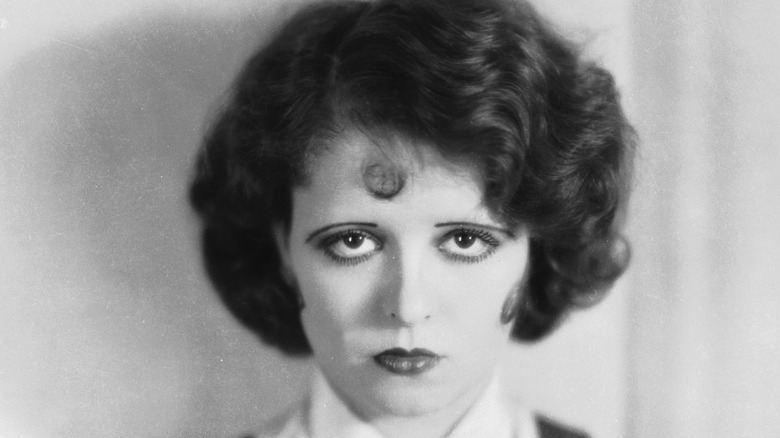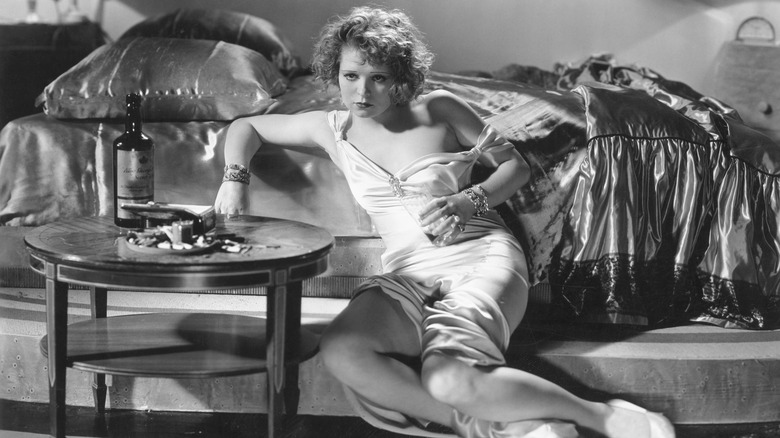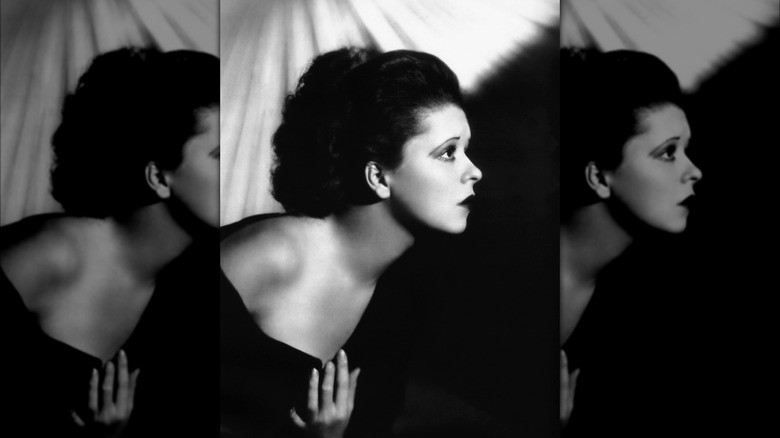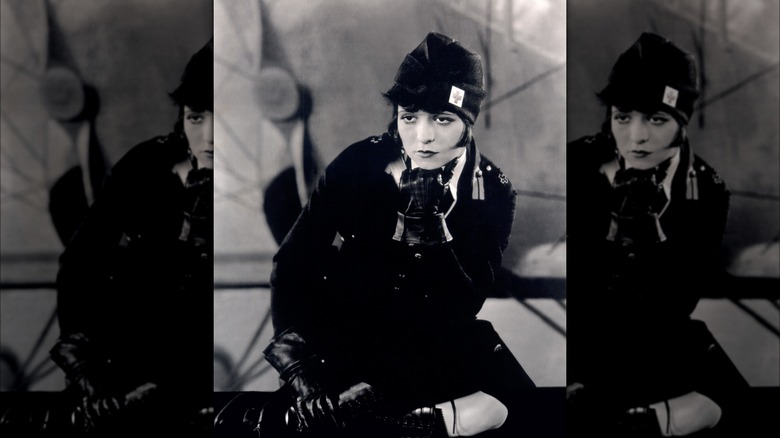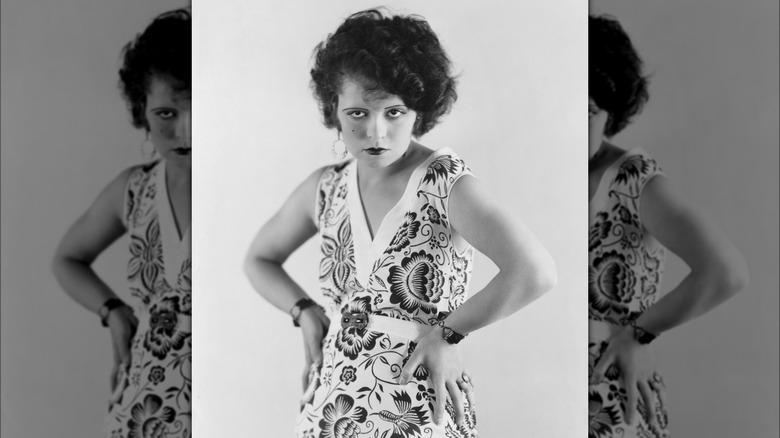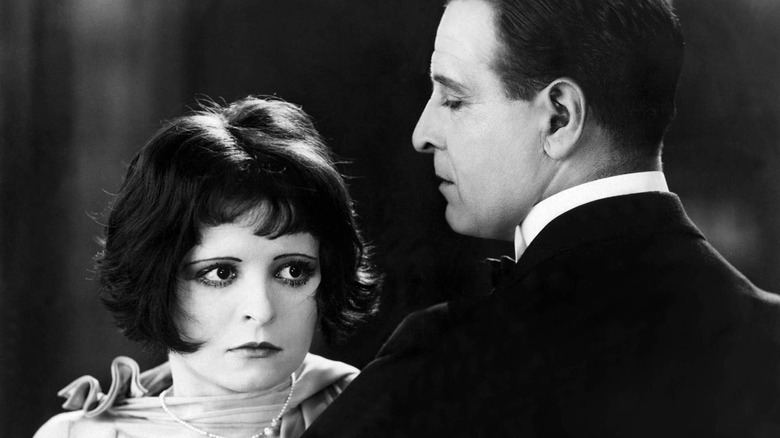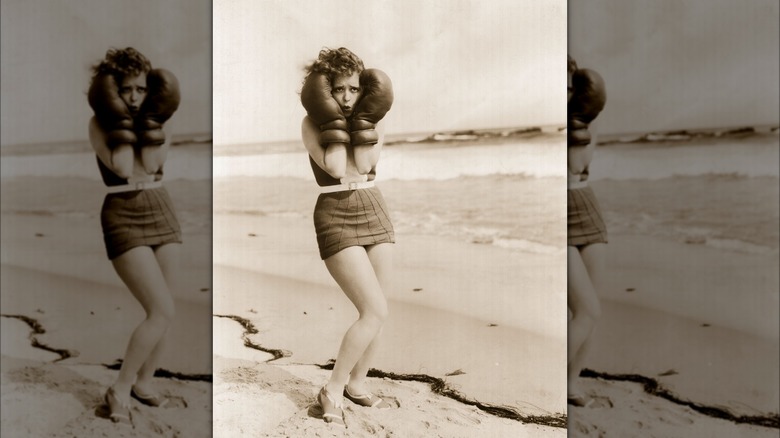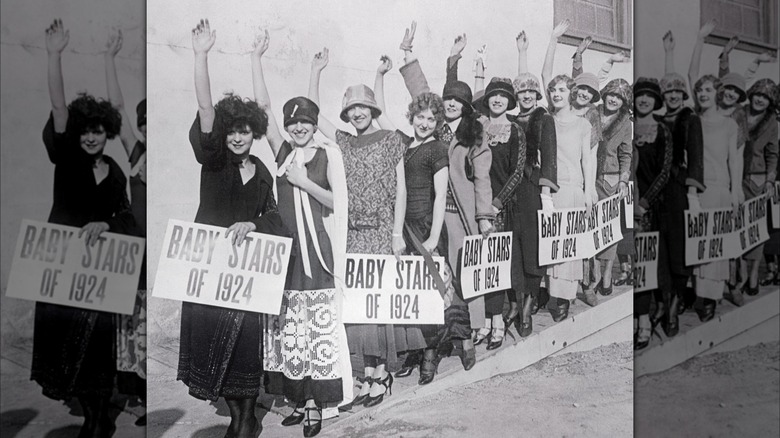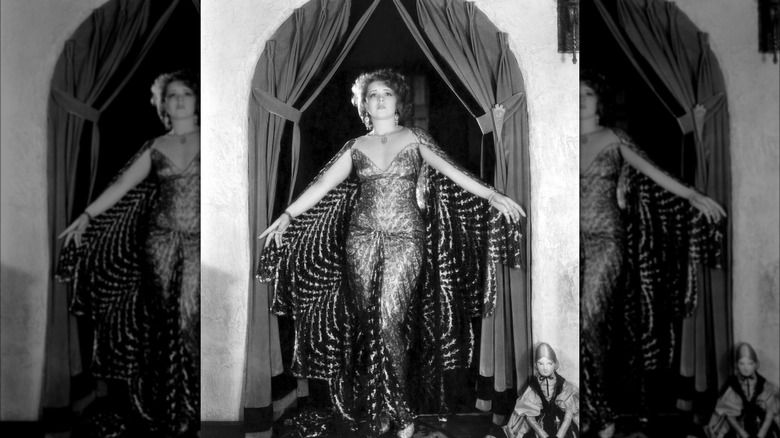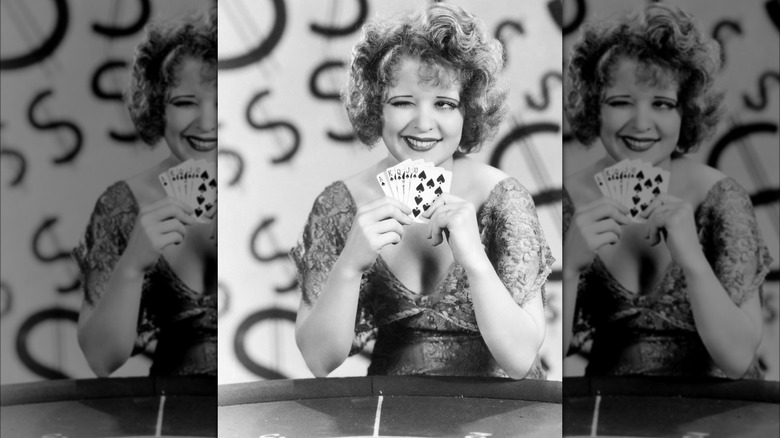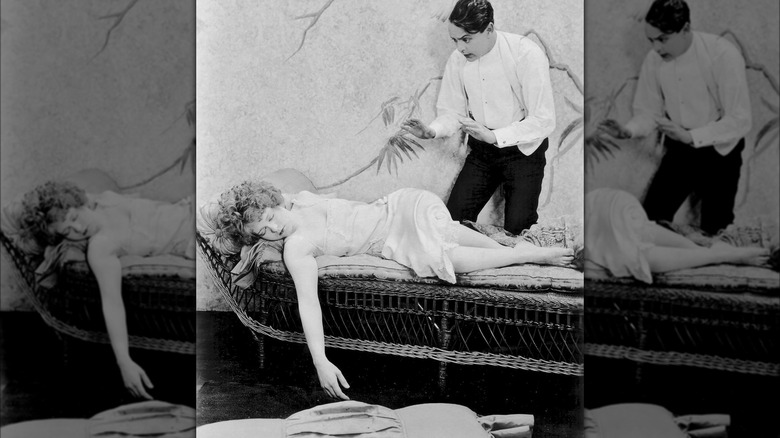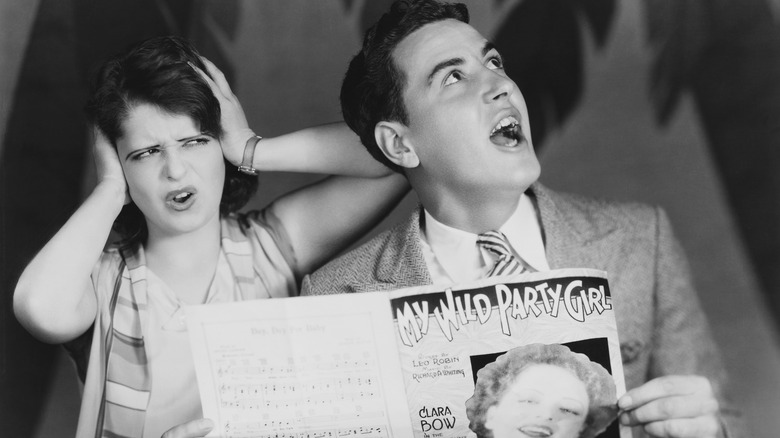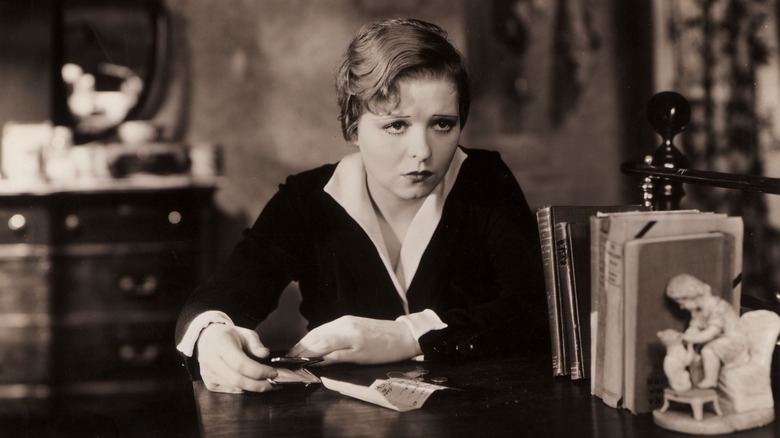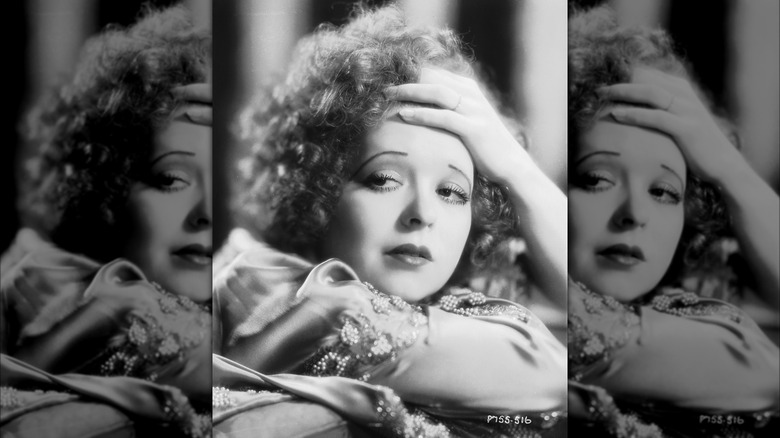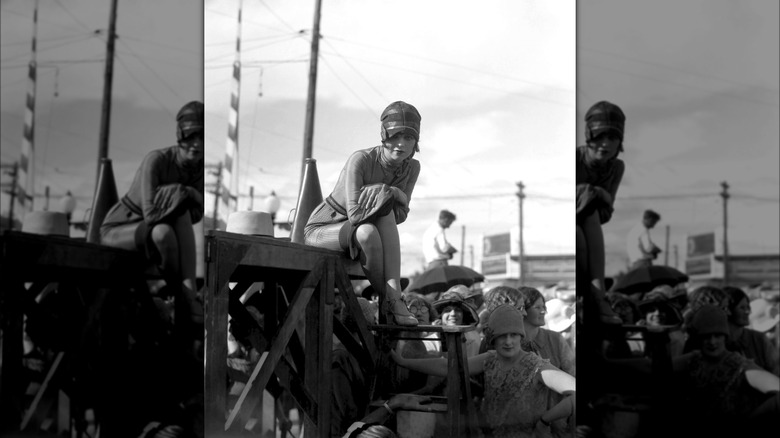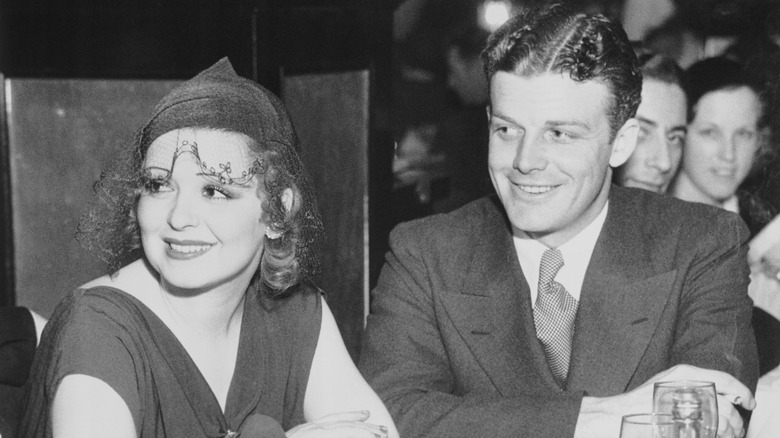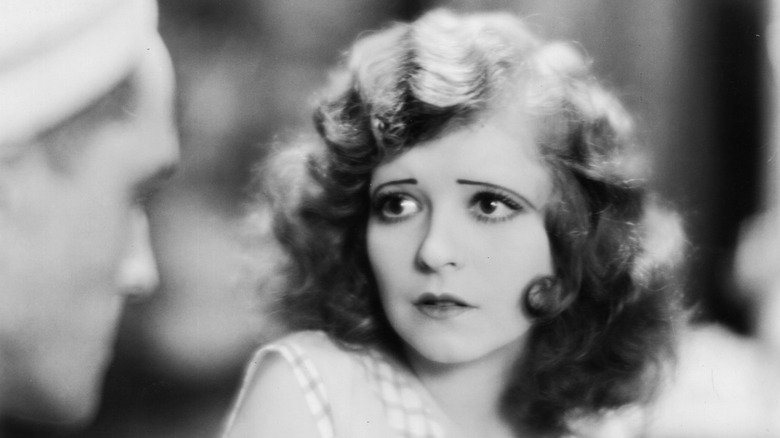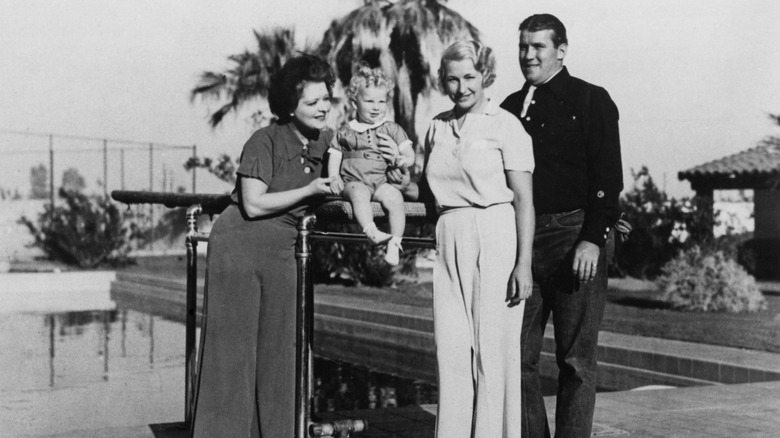Tragic Details About Clara Bow's Life
This article contains references to sexual assault.
Taylor Swift's announcement at the 2024 Grammys had many of her fans asking one question: "Who is Clara Bow?" When the "Anti-Hero" singer accepted her award for best pop vocal album, fans had no clue what was about to hit them. Not only did the pop star announce that her new album "The Tortured Poets Department" would be hitting shelves in April 2024, but she also promised she'd release more juicy details soon.
True to her word, the album's cover art and track list were soon making waves on the internet. With track titles like "I Can Fix Him (No Really I Can)" and "I Can Do It With a Broken Heart," speculation has run rampant that the album is heavily inspired by Swift's recent breakup with Joe Alwyn. However, one title — the last before the bonus tracks — still had some Swifties scratching their heads: "Clara Bow."
So who was she? If you had uttered the name 100 years ago, there would have been no confusion. The silent film star ruled over Hollywood in the 1920s and achieved fame and notoriety as Hollywood's first "It" girl. However, her life wasn't all glitz and glamour. While the champagne, money, and cars were most recently captured in the dark comedy "Babylon," in which Margot Robbie played a Bow-inspired character, the truth of the screen siren's life was much more tragic. Let's uncover some of the heartbreaks that haunted this pop culture icon.
Clara Bow's birthplace was referred to as 'hell on Earth'
The place? Brooklyn, New York. The time? July 1905. While nowadays, you might think of the bustling borough of New York City as hipster headquarters with its overpriced lattes and aspiring musicians in flannels and beanies, back in the early 20th century, Brooklyn was defined by its extreme poverty and unsafe living conditions. This was the Brooklyn that future starlet Clara Bow was born into on July 29, 1905.
Biographer David Stenn writes in his book "Clara Bow: Runnin' Wild" that the tenement neighborhoods in which Bow's parents lived were rat-infested, impoverished places. He goes as far as to describe these Brooklyn apartments as "slum buildings." In a time before sanitation regulations or health and safety codes, it was completely legal for landlords to cram their tenants into small homes with no windows, often with many families sharing a single toilet.
These conditions made the Bow family home a perfect breeding ground for disease. With no ventilation in the borough's small apartments, diseases like cholera, tuberculosis, and diphtheria were incredibly common. Infant mortality rates were high, and it was a wild stroke of luck that the little Clara made it to adulthood. According to Stenn, reformers of the early 20th century called the Bows' neighborhood "hell on Earth." In particular, records show that her parents, Robert and Sarah Bow, once lived at 160 Sands St. — one of the "roughest area[s] in America" at the time.
Her mother struggled with mental illness
Like many young girls, Clara Bow worshipped her mother. The young Sarah Bow, with her Brooklyn accent and harsh attitude, was the apple of her daughter's eye. However, instead of their connection blossoming into a loving relationship, Sarah's struggles with mental illness resulted in her daughter taking on the role of caretaker as well as, one might argue, victim.
Clara's grandmother also struggled with mental illness and, as biographer David Stenn reported, she was living in a facility for the "terminally insane" by the time Clara reached her first birthday. This could point to a genetic link as to why Sarah's mental health too began to deteriorate as the years went on. In 1911, a head injury accelerated her mental turmoil. While it's unclear if this was truly an accident or a failed suicide attempt, what biographers do know is that Sarah Bow tumbled down a flight of steps, resulting in her needing stitches.
A mysterious affliction followed. Without warning, she erupted into seizure-like "fits" that made breathing difficult. Sarah Bow would suffer from these fits, as well as deep depression, for the rest of her life. In addition to being her caretaker, Clara's safety was also often threatened by her mother's stormy moods. In one tragic instance, Clara awoke to her mother holding a knife to her throat. The next day, Robert Bow officially took his wife to a facility for treatment.
Clara Bow witnessed her grandfather's death
It's undeniable that Clara Bow's early life was defined by pain, tragedy, and want. Between her unstable mother and abusive father, her childhood in Brooklyn was one that no one should envy. However, her early days weren't all dark. One silver lining in the young Bow's life was the affection and love she received from her maternal grandfather, Frederick Gordon.
Bizarrely, Bow biographer David Stenn reported that Gordon was no loving husband or father. In fact, he was downright cruel to his daughter, Sarah, during her own childhood. However, with a baby on her hip and her husband spending a large amount of time away from home, Sarah decided to invite her father to move in with her and her 1-year-old daughter. The infant must have softened him because Stenn wrote that Frederick "treated his granddaughter with kindness and affection."
With Sarah struggling to manage her own failing mental health, Bow's grandfather seemed to have taken on the role of babysitter and playmate. He even built an indoor swing in the family's tenement in an attempt to make the home a bit warmer and more loving for his granddaughter. However, true to Bow lore, it wasn't long before tragedy struck. On January 20, 1909, the littlest Bow was flying high on her swing when her grandfather, who was pushing her, suffered a neurological episode. Clara's screams alerted her mother and the next day Frederick Gordon, Clara's primary caretaker, was declared dead.
She was abused as a child
With an ill mother and a grandfather tragically taken from her too soon, Bow's father soon became the primary parental figure in the young starlet's life. Unfortunately, multiple biographers claim that Robert Bow was an alcoholic and an abusive parent who viewed his daughter's fledgling career in the movies as a great way to pay off bar tabs and settle gambling debts.
In 1921, Bow got her start in entertainment after winning Brewster Publications' Fame and Fortune Contest. With the publicity the 16-year-old garnered from the beauty contest, she won some bit parts in films. However, this great career boost was overshadowed by the turmoil in her private life. While being interviewed for Stenn's biography, "Clara Bow: Runnin' Wild," a "prop man" named William Kaplan recalls working on several film sets with Clara Bow and how her father was almost always an "unwelcome" presence. Speaking with Stenn, Kaplan summarized their relationship by saying, "As long as she was working and making the money, he was happy."
Stenn's study of Bow's life also brought up evidence that her father had been sexually abusive to her in her teenage years. The biographer later spoke with LA Times about his research and drew parallels between Bow's abusive home life and her status in pop culture. For the 1999 article, he said, "If you look at the sex symbol in American film as a sexually abused girl acting out ... it's interesting."
If you or anyone you know has been a victim of sexual assault, help is available. Visit the Rape, Abuse & Incest National Network website or contact RAINN's National Helpline at 1-800-656-HOPE (4673).
Clara Bow witnessed her friend's death
Outside of the home, life on the streets of Brooklyn was also tough for the young Clara Bow. Her biographer reports that she was a lonely child who only had one true companion, a little boy named Johnny who lived in the same tenement. However, what was once a much needed friendship soon turned to tragedy when Johnny perished in a house fire.
Speaking to the celebrity magazine Photoplay in 1928, Bow gave an account of how the tragedy unfolded. "He was several years younger than I was," she said of Johnny, "and I used to take him to school with me, and fight the boys if they bothered him. I could lick any boy my size." It was after their school run one afternoon when Bow heard "a terrible noise" coming from downstairs.
What she found was Johnny aflame, having been caught in a house fire. Though she was just a child herself, the young starlet-to-be came to her friend's aid. She recalls Johnny screaming "Clara, Clara, help me" before falling into her arms. Bow said, "I laid him on the floor and rolled him up in the carpet and tried the best I could to put the fire out." Tragically, her efforts were to no avail and Johnny died in her arms. Looking back, Bow remembers crying "for hours" after the event. She said, "I have never cried but once like that since. That was when my mother died."
She had a childhood stammer
As a child, Clara Bow was an outsider. Her biographer David Stenn points to a childhood speech impediment as one of the main targets of her schoolmates' barbs and bullying ways.
According to Stenn, Bow was "acutely self-conscious" of her stammer, which made her stutter the first letter of a word. Today, medical professionals believe that mental or emotional trauma can cause individuals to adopt a stammer, which could explain why the young Bow suffered so deeply from the speech impediment, considering her early days were defined by an onslaught of death and abuse.
With medical and psychological knowledge severely lacking in the early 1900s, children at Bow's school saw her stammer as little more than a source of amusement. They constantly mimicked Bow's stammer and made fun of her clothes. With money tight at home, almost all of the future starlet's clothes were homemade her mother, using material from her own old shirtwaists. Looking back on this time in her life in her 1928 Photoplay interview, Bow said, "I was shy and nervous around girls. They were always hurting my feelings." The fact that these bullies remained top of mind even after Bow made it big in Hollywood points to just how deeply the experience cut her.
Hollywood bosses bullied her
If the #MeToo movement is anything to go on, Hollywood has not historically been a very safe or welcoming place for women. With today's biggest actresses still fighting to have their voice heard when they speak up about abusers and sexual predators in the industry, one can only imagine how hostile this environment was for an actress like Clara Bow who was working in the early days of the industry.
While Bow never had her own #MeToo moment, naming names and calling out toxic individuals, she did speak broadly in her later years about some of the bullying she received from Hollywood bosses and casting agents as a young woman trying to make it on the big screen. At the start of her career, rejection was everywhere. Often, this rejection came with a heavy dose of body shaming on the side. Later in life, Bow would reveal that her rejections were almost always down to her weight. She said, "I was too young, or too little, or too fat. Usually I was too fat."
Even when she hit the big time, the Hollywood elite still looked down their noses at this street smart girl from Brooklyn. Hollywood bosses in particular regularly made fun of what they saw as Bow's lack of intelligence. With a reputation as a "jazz baby," aka party girl, they weren't shy about calling Bow a "birdbrain" and "an easy winner of the Dumbbell Award," according to biographer David Stenn.
Clara Bow was a reluctant sex symbol
One of Clara Bow's most iconic films is the 1927 romantic comedy "It," in which she plays a lowly shop girl who has a crush on her much wealthier boss. The film has often been called Bow's "starring vehicle" and is credited as being the film that catapulted her into international stardom, as well as being the film that coined the phrase "It Girl."
But what does the title refer to exactly? It's simple: sexual charisma. The film was adapted from a novel by writer Elinor Glyn, who would tell Cosmopolitan in 1927 that "it" is "that quality possessed by some which draws all others with its magnetic force. With 'It' you win all men if you are a woman and all women if you are a man."
Not long after the release of the film, the American public decided that Bow herself possessed ample amounts of "it," launching her career as a sex symbol. There had been sex symbols in cinema before, such as the "vamp" Theda Bara, but none had the general appeal of the Betty Boop-esque Clara Bow. While her sexuality was making her (and studio executives) a lot of money, it was a role that made Bow miserable behind closed doors. Her partially nude scenes became something she would regret later in life, saying, "I don't want to be remembered as somebody who couldn't do nothin' but take her clothes off."
Her partying ways made her an outsider
Like many performers who make their living stepping into different characters and situations, the line between persona and real life soon began to blur for Clara Bow. In film after film, she was typecast as a "jazz baby" — a fresh young thing who wore all the latest flapper fashions and loved drinking, dancing, and flirting. However, her real life wasn't too far off.
She was a rebel and a party girl, flying in the face of what the buttoned-up Hollywood elite expected of her as their biggest star of the era. Film historian Jeff Crouse spoke with the Daily Mail about Bow's antics and how they impacted her reputation in Tinseltown, claiming, "She was free-spirited and loved sex. Men would fall at her feet, and she had affairs with some of Hollywood's most desirable men, such as actors Gilbert Roland, Gary Cooper, and film director Victor Fleming."
Stories abounded about Bow's wild ways, including an incident in which she was invited to a posh dinner by film director Frank Tuttle only to turn up dressed in nothing but a bathing suit. While this rebellious behaviour would be charming coming from a zany film character, in real life, it only resulted in Bow being ostracized from Hollywood society. One fellow actress from the 1920s recalled Bow's standing in society by saying, "She wasn't well liked amongst other women in the film colony. Her social presence was taboo."
She became addicted to sedatives
One man who was interviewed in David Stenn's 1998 biography, "Clara Bow: Runnin' Wild" recalls a brief encounter with the starlet that took his breath away. While working as an "office boy" for one of the major Hollywood studios when he was a teenager, John Engstead witnessed Bow running into the publicity offices one day with an energetic air. "I've never taken dope," said Engstead, "but it was like a shot of dope when you looked at this girl."
Unfortunately, Bow couldn't say the same for her own sobriety. Like many Hollywood stars before (and after) her, addiction soon came to play an integral role in her story. A 1929 issue of the celebrity magazine Photoplay described "rows of bottles of sedatives" on the table next to Bow's bed, the better to quiet her "active, restless, undisciplined brain." In sympathy, the reporter wrote, "Maybe Clara has worked too hard."
Stenn wrote that Bow was drawn to sedatives to help cure her insomnia. He wrote that, later in life, the former star kept strange, nocturnal hours, taking sedatives at sunrise that would then cause her to sleep throughout the day. She would rise in a "drugged stupor" later in the day and then repeat the cycle over again. It wasn't until an older Bow was under the care of Dr. Karl von Hagen, a famed Los Angeles neurologist and psychiatrist, that she was officially prescribed sedatives, but he reportedly wrote the script very "reluctantly."
If you or anyone you know needs help with addiction issues, help is available. Visit the Substance Abuse and Mental Health Services Administration website or contact SAMHSA's National Helpline at 1-800-662-HELP (4357).
Talkies nearly ruined her career
Between 1926 and 1930, a sound revolution took place in Hollywood. Thanks to technological advancements, the days of the silent film — and thus, the silent film star — became a thing of the past. This was a jolt for many actors and actresses who had carved an entire career out of being incredibly expressive physically and acting out narrative after narrative without the use of their voice.
Clara Bow was one such actress who had overcome insecurity and ridicule to make it in the "talkie" era. Hailing from the rough streets of Brooklyn, New York, Bow retained a thick accent her whole life and was nowhere near the type of vocal talent audiences would find in stars who had managed to master the Transatlantic accent — a combination of British Received Pronunciation and American English accents that film stars were encouraged to adopt to highlight their elite status.
Bow's childhood stutter also caused her much inner turmoil. Paramount Studios reportedly gave the star "two weeks" to prepare for the filming of her first talking picture, 1929's "The Wild Party." Although the movie would go on to become a box office success, "The Wild Party" made Bow's Brooklyn accent an inextricable part of her public persona. In fact, a parody of Bow can be seen in 1952's "Singin' in the Rain," which features an airhead actress figure whose thick accent makes her a laughingstock on set.
Clara Bow's secretary betrayed her
Loyalty can be hard to come by for the rich and famous, and this was true for Clara Bow. Making and keeping confidants when the entire world wanted to eavesdrop in on the 1920s "It" girl's dirty secrets was no easy feat. For Bow, she learned the hard way that money and fame corrupt even those you would least expect.
In 1929, Hollywood was rocked by the arrest of Daisy DeVoe, a woman who had once been Bow's personal secretary. It was announced that DeVoe had been embezzling large chunks of Bow's fortune — we're talking six figures, here — and attempting to blackmail her former employer. According to Matt MacNabb's 2020 book "Hollywood's Dark History," the case kept getting messier. In retaliation for ruining her image in the press, DeVoe tried to hurt her old friend even more by sitting down for an interview with The Coast Reporter, a celebrity tabloid notorious for its seedy dealings.
DeVoe told sensational stories of Bow's partying ways, accusing her of drug use and wild affairs. The front page headline of the following edition of The Coast Reporter read, "Clara's Secret Love Life as told by Daisy to Frederic H. Girnau." The stories soon made their way into papers around the country and the scandal was no longer focused on DeVoe but on the screen siren's scandalous personal life.
At 25, she checked into a sanitorium
What followed from the Daisy DeVoe trial can only be called a PR nightmare. Clara Bow's reputation, and thus her relationship with the studios, was in free fall. With the country's tabloid readers pegging her an unrepentant party girl, her employers were unsure how to cast her going forward. In fact, the original Coast Reporter article outright called Bow "morally unfit" to be on-screen and called on Paramount executives to terminate her contract.
Not one to cower from tabloid journalists, the head of Paramount decided to give her one more shot. Bow was cast in a film called "The Secret Call," but the filming schedule — on top of the media firestorm — proved too much. Before the film could be completed, the harried starlet suffered from a nervous breakdown. Biographer David Stenn recounted in "Clara Bow: Runnin' Wild" that Bow's housekeeper awoke one night to terrifying screams coming from the star's bedroom.
She simply couldn't face another morning of filming. Bow's lover and future husband, Rex Bell, drove her the 25-year-old to a facility called the Glendale Sanitarium. After years of hard living and hard work in Hollywood — and with her name now trashed by every tabloid in town — Bow had simply had enough. The medical staff diagnosed her with "shattered nerves." "It would be dangerous," one doctor wrote, "for her to make a picture at this time." And with that, a chapter of the Bow saga had closed.
In 1944, Clara Bow tried to take her own life
Tragically, Bow's addiction to sedatives hit a climax when she purposefully overdosed in 1944. By this time, the former star had left Hollywood for her mental health and resided in Nevada with her husband, Rex Bell, and their two sons Tony and George. This "desert paradise," as Clara once called their home, was dubbed Ranch Clarita after Rex's nickname for his wife.
However, the heavenly glow of the ranch didn't last long, and Bow's mental illness eventually came to a breaking point. Her biographer David Stenn recounted one morning when Tony and George brought their mother breakfast in bed. However, instead of lifting her spirits as the two young boys hoped it would, what they discovered would change the course of their lives forever.
Unconscious in her bed, they discovered that their mother had swallowed more sedatives than her usual dose in an attempt to take her own life. They ran to a neighbor's house to ask for help, and a medical team eventually arrived. It was Tony, Bow's eldest son, who found the note she had intended for her husband. According to Stenn, Bow's suicide note confessed to how harrowing she had found public life, admitting that she "preferred death." Fortunately, Bow's already high tolerance for the drug saved her life and she was conscious by the time the ambulance reached the hospital. There, she reportedly asked her nurses for a cigarette.
Her marriage fell apart
While Clara Bow had many relationships in her day, the one that actually made it to the altar was her relationship with fellow actor Rex Bell. He too had gone to Hollywood looking to make a name for himself in the pictures. Where Bow made a fortune as the bright-eyed ingenue, Bell found his niche as a cowboy type in Western films. However, their paths crossed in 1930 on the set of "True to the Navy," and the rest is history.
Just one year later, the two were wed in the state of Nevada — Rex's desert haven away from the bustle of Hollywood. While their relationship took off, Bow's career and mental health began to decline. Eventually, she said goodbye to the pictures, and Rex was beginning a career as a politician. Although theirs was one of the few show business relationships to make it out of Tinseltown intact, Bow's mental health challenges eventually led to the deterioration of their marriage.
While Rex soon became a leader in his Nevada's Republican Party and owned one of the largest plots of land in the state, his shattered wife became more reclusive. Bow was anxious and hated public life. After her second stint in a mental institution, Bow and her husband decided that they would remain married but live apart. While Rex remained in Nevada, Bow moved back to Los Angeles so she could be close to her doctor.
In her later years, she underwent shock therapy
Treatment for mental health in the 1930s and 1940s was not what it is today, and as a result, many patients suffered. Despite all her money, fame, and street smarts, the screen icon Clara Bow was not spared this fate. She was eventually diagnosed with schizophrenia, and the road to recovery included several rounds of electroshock therapy. Otherwise known as electroconvulsive therapy, or ECT, this form of therapy includes "sending an electric current through your brain" (via Mind).
The goal was that this electric current would cause a minor seizure, resulting in some relief from the mental turmoil. While many modern doctors still support the use of ECT in certain situations, the practice is controversial and caused much harm when it was first introduced in 1938. This is largely because the aftereffects of ECT can include long-term and short-term memory loss.
In David Stenn's biography of Bow, her son Tony remembered that his mother was in denial about the real cause of her ECT treatment. While her doctor chose it to help ease the pain of her schizophrenia, Tony recalled that Bow told him, "I'm gonna get shock treatment so I can sleep right." While she had struggled with insomnia throughout her life, this was only one mental battle she felt, but not the full war. In a tragic turn, the girl from Brooklyn's life would turn out not that dissimilarly from her mentally ill mother's life after all.
Clara Bow became a recluse
Clara Bow's life was nothing if not a roller coaster ride. From her traumatic childhood on the rough streets of Brooklyn to reigning as the queen of Hollywood and her own desert paradise, Bow's life reads like something out of a work of fiction. With epic highs and even more epic lows, the journey of this early film star was not without its tragic moments.
By the end of her life, Bow was living away from her two sons and her estranged husband. She remained in close contact with her mental health team and was involved in ongoing therapies. Later in his life, Rex Bell summarized his wife's condition by saying, "The emotional strain of her early years was just too much for her. She had to live a different life. She needs the constant care of a doctor."
After so many years hounded by photographers and journalists, it's no surprise that the former "It" girl eventually chose such a reclusive way of life. Her fear of public attention and crowds was so great that when Bell died in 1962, Bow — the mother of his two children — appeared at his Los Angeles funeral for only a few minutes. In David Stenn's study of Bow's life, he remarked that aside from holiday shopping and doctor's appointments, "she would never leave home again." It was there that a 60-year-old Bow died of a heart attack on September 27, 1965, with only her live-in nurse by her side.
If you or someone you know is struggling or in crisis, help is available. Call or text 988 or chat 988lifeline.org.
